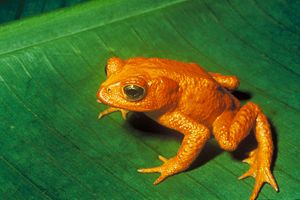Dramatic declines in amphibian populations, including population crashes and mass localized extinction, have been noted since the 1980s from locations all over the world. These declines are perceived as one of the most critical threats to global biodiversity, and several of causes are believed to be involved, including habitat destruction and modification, over-exploitation, pollution, pesticide use, introduced species, climate change, increased ultraviolet-B radiation (UV-B) and disease. However, many of the causes of amphibian declines are still poorly understood, and the topic is currently a topic of much ongoing research. Calculations based on extinction rates suggest that the current extinction rate of amphibians is could be 211 times the background extinction rate and the estimate goes up to 25,039-45,474 times if endangered species are also included in the computation
In the past three decades, declines in populations of amphibians (the group of organisms that includes frogs, toads, salamanders, newts, and caecilians) have occurred worldwide. In 2004, an international convention of amphibian biologists announced that 32 percent of species are currently threatened, 43 percent were declining in population, and that 120 species are likely to have become extinct since the 1980s.
Declines have been particularly intense in the western United States, Central America, South America, eastern Australia and Fiji (although cases of amphibian extinctions have appeared worldwide). While human activities are causing a loss of much of the world's biodiversity, amphibians appear to be suffering much greater effects than other species of organisms. Because amphibians generally have a two-staged life cycle consisting of both aquatic (larvae) and terrestrial (adult) phases, they are sensitive to both terrestrial and aquatic environmental effects. Because their skins are highly permeable, they may be more susceptible to toxins in the environment than other organisms such as birds or mammals. Many scientists believe that amphibians serve as "canaries in a coal mine," and that declines in amphibian populations and species indicate that other groups of animals and plants will soon be at risk.
Declines in amphibian populations were first widely recognized in the late 1980s, when a large gathering of herpetologists reported noticing declines in populations in amphibians across the globe. Among these species, the Golden toad of Monteverde, Costa Rica featured prominently. The Golden Toad, Bufo periglenes, was the subject of scientific investigation until populations suddenly crashed in 1987 and disappeared completely by 1989. Other species at Monteverde, including the Monteverde Harlequin Frog (Atelopus varius), also disappeared at the same time. Because these species were located in the pristine Monteverde Cloud Forest Reserve, and these extinctions could not be related to local human activities, they raised particular concern among biologists.
When amphibian declines were first presented as a conservation issue in the late 1980s, some scientists remained unconvinced of the reality and gravity of the conservation issue. Some biologists argued that populations of most organisms, amphibians included, naturally vary through time. They argued that the lack of long-term data on amphibian populations made it difficult to determine whether the anecdotal declines reported by biologists were worth the (often limited) time and money of conservation efforts.
However, since this initial skepticism, biologists have come to a consensus that declines in amphibian populations are a real and severe threat to biodiversity. This consensus emerged with an increase in the number of studies that monitored amphibian populations, direct observation of mass mortality in pristine sites that lacked apparent cause, and an awareness that declines in amphibian populations are truly global in nature.
Numerous potential explanations for amphibian declines have been proposed. Most or all of these causes have been associated with some population declines, so each cause is likely to affect in certain circumstances but not others. Many of the causes of amphibian declines are well-understood, and appear to affect other groups of organisms as well as amphibians. These causes include habitat modification and fragmentation, introduced predators or competitors, introduced species, pollution, pesticide use, or over-harvesting. However, many amphibian declines or extinctions have occurred in pristine habitats where the above effects are not likely to occur. The causes of these declines are complex, but many can be attributed to emerging diseases, climate change, increased ultraviolet-B radiation, or long-distance transmission of chemical contaminants by wind.
